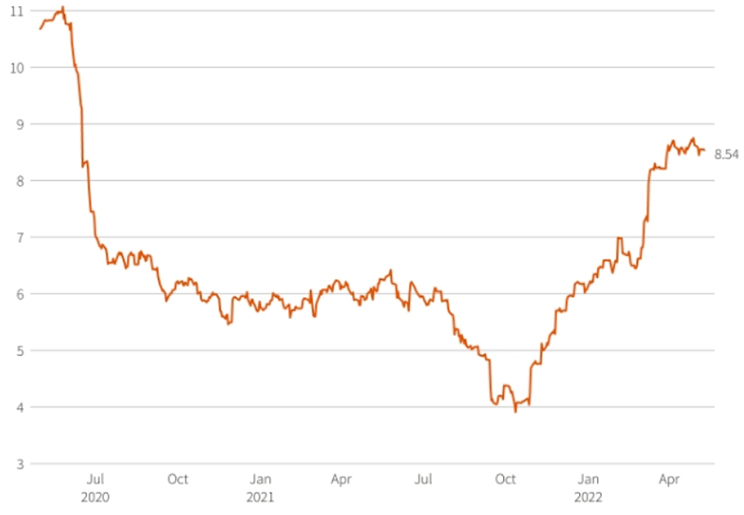Before 2009, money existed only in physical format. With the development of computers and the Internet, financial and trade settlements became electronic. They are actively used in non-cash transactions in investment, trading activities, and also act as a means of payment. The main difference between cryptocurrency and digital currency is its decentralized blockchain and the lack of control over the circulation of coins by the state.
Varieties of money
The difference in functions led to the division of means of payment into several types. The first trade relations needed a system to determine the price. Until the middle of the last century, gold was used, then countries switched to national paper money without collateral. Their rate is determined by the level of confidence in the state that issued them.
With the development of computer systems, the physical format of money began to yield to the virtual one. Bank transactions began to be carried out electronically. It became easier to control the turnover of transactions in the fiat money market. Financial companies began to provide information about users’ accounts to central government agencies. Cryptocurrency made transactions fast and anonymous while maintaining data security. The reason for the popularity of digital coins is their ease of use and low fees.
Fiat
Traditional money is centralized and depends on the monetary policy of the national authority responsible for issuing it. They are legal tender. Their advantages:
- Low volatility. Fluctuations in the exchange rate of currencies such as the U.S. dollar do not exceed 10% per year.
- Populaarsus. Fiat money payments are available in any store.
- Reversibility of transactions. If fraud is detected, the bank can cancel the transaction and return the funds to the account.

Digital
This is the full analog of fiat currency, translated into electronic form. In order for money to appear in the account, it must be physically deposited there via a bank teller or payment terminal. Within the modern financial system, funds can be sent anywhere in the world. However, there are some disadvantages:
5020 $
boonus uutele kasutajatele!
ByBit pakub mugavaid ja turvalisi tingimusi krüptovaluutaga kauplemiseks, pakub madalaid vahendustasusid, kõrget likviidsust ja kaasaegseid vahendeid turuanalüüsiks. See toetab spot- ja finantsvõimendusega kauplemist ning aitab algajaid ja professionaalseid kauplejaid intuitiivse kasutajaliidese ja juhendmaterjalidega.
Teenida 100 $ boonust
uutele kasutajatele!
Suurim krüptovahetus, kus saate kiiresti ja turvaliselt alustada oma teekonda krüptovaluutade maailmas. Platvorm pakub sadu populaarseid varasid, madalaid vahendustasusid ja täiustatud vahendeid kauplemiseks ja investeerimiseks. Lihtne registreerimine, kiire tehingute kiirus ja usaldusväärne rahaliste vahendite kaitse teevad Binance'i suurepäraseks valikuks mis tahes taseme kauplejatele!
- Identification – low anonymity. To create an account, any financial organization requires an identity confirmation procedure.
- Purpose of payment – the user must explain why he is sending money.
- Speed of transactions – banking transactions take a long time (up to several days).
Krüptovaluutad
The launch of Bitcoin in 2009 – the beginning of assets based on blockchain technology. Next came altcoins, which stayed true to the original principles:
- Decentralized issuance and circulation of coins. Regulated by the issuance algorithm without intermediaries.
- Anonüümsus. Personal user data is not needed to register a wallet.
- Infoturve. Provided by special cryptography.
- Avatus. All transactions, except for a few anonymous projects like Monero, contain open information.
Krüptovaluutade liigid
Blockchain is the base for launching many coins and projects with a variety of functions. There are several types of coins depending on:
- Generation.
- The encryption algorithm.
- The method of mining.
- The presence of its own blockchain.
The main differences between cryptocurrency and digital currency
Being electronic money, these two types of assets have a big difference. It depends on the issuance and regulation of the exchange rate. Cryptocurrency is issued by an algorithm where the issuance mechanism is transparent to all participants and the value is determined by the balance of supply and demand. Digital money is fiat money, only converted into electronic form, while retaining all the characteristics of traditional money.
The most important difference is that cryptoassets have a hard time holding a stable value. This can make it difficult to introduce them into everyday life and use them in business, where even small price changes can cause profits to disappear, leaving sellers at a disadvantage.
Detsentraliseerimine
Blockchain technology allows information to be exchanged online and the chain to operate without a single server or node. Copies of the database are stored on a large number of computers, providing a high degree of protection against changes.
Anonüümsus
Unlike a bank account, a cryptocurrency wallet does not need identity verification. Users do not pay for account maintenance and can own an unlimited number of addresses. Though every transfer is traceable, the information itself does not contain sensitive data.
Läbipaistvus
Cryptocurrency is based on blockchain technology – a distributed public ledger. All transactions form a chain, and the information is available to any participant. At the same time, transfers of such currency are protected by bank secrecy, they cannot be accessed.
Fiat currencies lack transparency because all monetary and fiscal policies are made by central governing bodies such as banks and governments.
Transaction Management
In a traditional financial system, monetary transactions are reversible. Government supervisors are called upon to regulate such processes. The centralization of the financial system allows a payment to be reversed at any stage of its execution.
A cryptocurrency transaction, once confirmed, cannot be canceled or deleted, even if it was sent to an erroneous or non-existent address. This is because there is no central authority that can regulate changes to the blockchain.
Määrus
Most countries around the world have already developed legal regulations regarding the circulation of cryptocurrency. In Russia, since January 2021, there is a law on digital assets, which regulates the rules for buying and selling coins.
In Belarus, operations with such assets are normalized by Decree No. 8. Electronic currencies in the global financial system operate within the legal framework thanks to EU Directive 110 of 2009 and Article 4A of the U.S. Commercial Code.
Kaevandamine
Another difference between cryptocurrency and digital currency is that it can be mined. Proof-of-Work methods in the blockchain are categorized into:
- Proof-of-Work(PoW). It is a solution of cryptographic algorithms to validate transactions and bring them into a single chain. The success of the work depends on the processing power of the hardware in the network. The more users are involved in mining, the more complex the computation becomes. This requires huge investments and energy costs. Bitcoin and Ethereum are the projects that work on this method.
- Proof-of-Stake (PoS). Transactions are confirmed using valideerijad. Such participants must freeze the cryptocurrency in the account to be able to write new data to the block. This method does not require large computing power, and many projects are already working on such an algorithm or are preparing to switch to it soon.
Eelised ja puudused
Like any means of payment, electronic currencies and coins based on cryptographic algorithms have features. They manifest themselves in the usability and methods of protecting the confidential information of participants.
Digital money
Being a legal means of payment, they have certain pros and cons.
| Eelised | Puudused |
|---|---|
| Stable exchange rate. Not subject to sharp fluctuations in quotations, the price is created by the national issuer. | Tsentraliseerimine. Regulation and change of rules of currency circulation. |
| Populaarsus. It is possible to pay on all Internet sites. | Lack of confidentiality. Bank account requires identity verification procedure. |
| Reguleerimine. Legal tender. | Inflatsioon. Growing money supply reduces purchasing power. |
Krüptovaluutad
Projects on distributed database technology – with characteristics that distinguish them from digital currencies, as well as strengths and weaknesses.
| Eelised | Puudused |
|---|---|
| Anonüümsus. You don’t need the owners’ personal information to transfer coins between addresses. | Volatiilsus. Sharp price spikes are caused by insufficient market liquidity. |
| Detsentraliseerimine. There is no risk of a complete ban on the use of cryptocurrency. | Legal status. Operations with digital assets are in an unregulated zone. |
| Turvalisus. Data security is ensured by cryptographic algorithms. | Mining process. For the operation of the protocol on the PoW method, large computing power is required. |
Kokkuvõte
The development of blockchain technology affects the financial system, attracting new users. The main difference between cryptocurrency and digital money is that it has gone beyond a means of payment. Today it is a full-fledged network of popular projects with products to solve many modern problems.
Digital currencies received all the disadvantages of fiat money, which was the reason why it was impossible to change the banking system. Cryptocurrency provides transfers to any place, while offering low fees, security and speed of transactions. This advantage over fiat money has caused a high demand for financial services and a rise in the price of coins. Despite the fact that some states (e.g. China) are struggling with digital assets, their turnover and kapitaliseerimine is growing.

Users see the advantage of a decentralized blockchain, namely the lack of government regulation. Cryptocurrency projects receive funding to realize products that will impact the entire world.
Korduma kippuvad küsimused
💲 How does digital currency differ from virtual currency?
The former is issued by a central authority. It is a legal method of payment. The second is used by payment systems (e.g. WebMoney) and exists only in a virtual environment.
❓ How is the exchange rate of fiat money and cryptocurrency determined?
The price of digital assets is influenced by supply and demand on the market. Traditional means of payment are also influenced by monetary policy and the economic situation in the issuing country.
❗ How is the PoS method better than PoW?
Validators do not need large computing power. And the growth of transaction validation nodes increases the throughput of the blockchain.
🔧 How is data protected on the blockchain?
All information is encrypted with special cryptography.
💰 How to open a cryptocurrency account?
Kas tekstis on viga? Märkige see hiirega ja vajutage Ctrl + Sisesta
Autor: Saifedean Ammous, krüptorahanduse ekspert.















